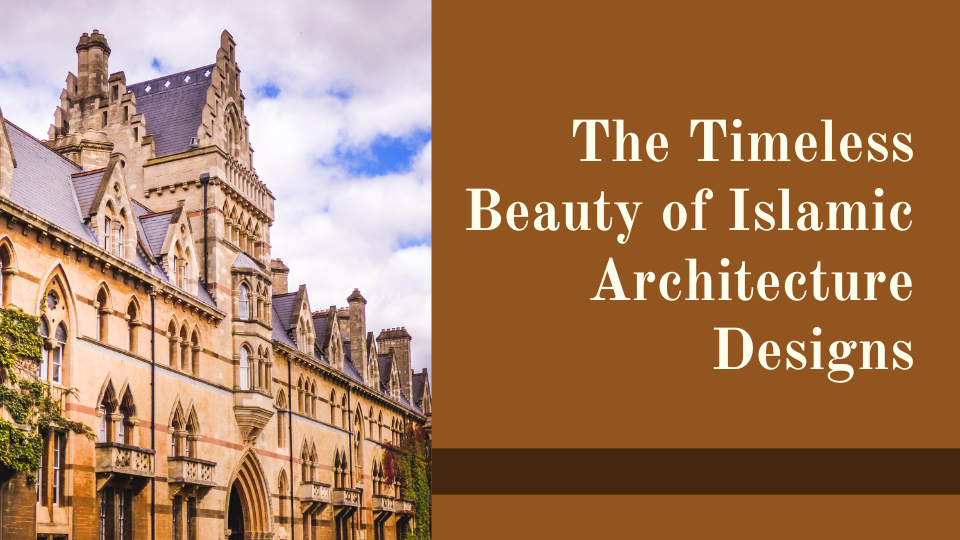The Timeless Beauty of Islamic Architecture Designs

Islamic architecture is an architectural style associated with the religion of Islam and, has evolved from various architectural styles like that of Mesopotamian and Roman. As centuries passed, Islamic architecture got influenced by other contemporary styles like Chinese architecture and Mughal Architecture. Islamic Architecture was also affected by a variety of revisions that were decreed necessary during Colonial Rule.
Some famous heritage sites and buildings belonging to Islamic Architecture include Mosques, Forts, Palaces, and Tombs.
Also Read:- A Overview Of Turkish Vernacular Architecture
Here are some of the distinctive elements of Islamic Architecture:
1. Domes | Islamic Architecture
Domes usually appear as a part of roofs and ceilings and, are hemispherical structures. Domes can stand upon a rotunda structure, a drum, or a system of interlocking pendentives. The apex of the dome may feature an Oculus to permit natural light inside.
Domes made its first appearance in Mesopotamian Architecture. The Islamic Architecture adopted the dome as one of its main features after getting influenced by the model of the pre-existing Byzantine domes in Ottoman architecture. Different types of domes include Onion Domes, Beehive Domes, Braced Domes, Coved Domes, Compound Domes, Crossed-Arch Domes, Ellipsoidal Domes, Geodesic dome etcetera.
2. Arches
Arches are prominent elements found in Islamic Architecture and their placement usually defines the entrances to buildings and rooms. Different types of arches include the Pointed Arches, Ogee Arches, Horseshoe Arches, and Multifoil Arches. The double-arched system of the Mosque-Cathedral of Córdobaand, the pointed arches of the Al-Aqsa mosque provide excellent examples of how arches become indispensable features of Islamic architecture.
3. Muqarnas | Arabic Architecture
Muqarnas resemble stalactites or honeycombs and become the 3d sculptural ornamentations that often appear as a part of vaults. The underside of domes, pendentives, arches, vaults, squinches etcetera usually host the Muqarnas.
The word ‘Muqarna’ stems from the Arabic word ‘Qarnasi’ meaning ‘Intricate Work’. The Muqarnas form an integral part of Islamic Architecture as it symbolizes the vastness and complexity of Islamic ideology.
Muqarnas made its first appearance in the Mesopotamian region and the North-Eastern Iran region. One of the largest Muqarnas belongs to the Jazira region of Eastern Syria and Iran.
4. Minarets
Minarets appear as a part of the architecture of Mosques in the form of towers and it often features one or more balconies. The towers act as visual aids to direct people towards the mosque, and they also act as focal points during the Islamic call for prayers. The forms of the minarets commonly seen range from thick, squat, spiral ramps to soaring, delicate, pencil-thin spires. The base of these minarets is usually square in shape. The number of minarets found in mosques varies from one to six. These towers stand as the ‘Landmarks of Islam’. Qutub Minar of India and the Spiral Minaret of Samarra in Iraq are famous Minarets belonging to Islamic Architecture.
5. Mihrab | Islamic Architecture
Mihrab, an architectural element, marks the direction of Qibla. It appears as a semicircular niche in the wall of a mosque and, the wall, commonly addressed as the ‘Qibla Wall’, helps to symbolize the direction of prayer.
The mihrabs of Mosque-Cathedral of Córdoba and The Great Mosque of Damascus highly decorative and, these beautiful mihrabs of the world exhibit inlays of precious stones and expensive materials. Sometimes these Mihrabs feature Muqarnas as ornamentation.
6. Arabesque Art
Islamic Decorations include geometrical patterns, floral motifs, and calligraphy. The Roman, Greek, and Sasanian cultures have inspired Islamic architecture to use symmetrical patterns. Islamic art and architecture commonly feature the eight-pointed star patterns. The Islamic legends state that it can capture djinns, genies, the immaterial counterparts to humans. All Islamic decorations are symmetrical and usually follow a spiral path from which leaves and flowers sprout. No parts of the seamless Islamic design take visual prominence and the design mimics an undulating sea through repetition and careful arrangement of the motifs.
7. Hypostyle Hall
Hypostyle Halls entered the Islamic world during the Umayyad Dynasty. The shape of these halls are typically rectangular or square, and the columns are arranged according to a grid pattern. The columns provide the impression of a boundless expanse, increasing the spiritual metaphor and visual aesthetics which narrates the description of the groundwork behind the existing science, technologies, and civilizations.
Mosques constructed using the hypostyle hall became one of the two main types of mosque construction. In congregational mosques, the prayer halls follow the hypostyle form. The Hagia Sophia mosque, located in the city of Istanbul proves to be a good instance of a hypostyle mosque.
8. Courtyards | Arabic Architecture
Most mosques and palaces belonging to Islamic Architecture feature large courtyards that can house large gatherings of people during festive occasions and prayers. Arcades surround these courtyards. These courtyards feature fountains for the people to perform ablution before prayers.
9. Gardens
These gardens provide respite during summers to the people. The gardens display water features like large marble fountains and ponds adorned with lotuses and lilies. These gardens often have a quadrilateral layout. The Holy Qur’an features many references to gardens which symbolises paradise on earth. Islamic gardens also can be linked to serenity and literary sense. The Charbagh located in proximity to TajMahal is a good example of an Islamic garden.
10. Iwan | Islamic Architecture
An Iwan, a rectangular hall with walls on three sides and an open side, has a vaulted roof. Pishtaq, the entrance of the Iwan, is decorated with friezes of calligraphy, glazed tilework, and geometric. The arched portal often opens into a courtyard. The Iwan of the Jammeh Mosque of Isfahan is an ideal example of the arcuated hall.







